Why are cathedrals hosting helter-skelters and golf courses?
- Published
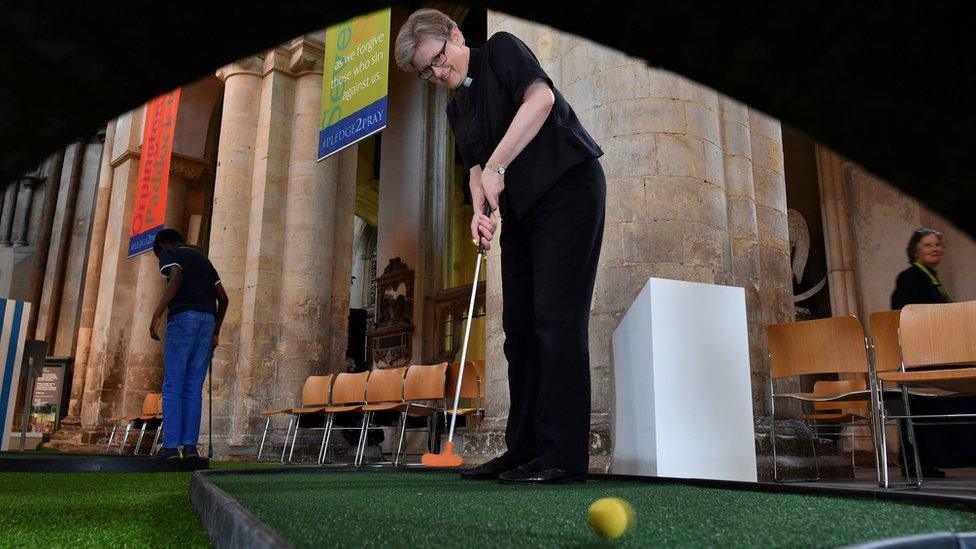
More than 31,000 people visited Rochester Cathedral during the six weeks the golf course was there
From giant models of Earth and the Moon to a helter-skelter and crazy golf course, cathedrals are increasingly playing host to large artworks and attractions. Why are buildings built for worship being used in the pursuit of fun?
Cathedrals might traditionally be viewed as hallowed places meant for sombre reflection and hushed reverence.
Vast, vaulted ceilings soar high over whispering huddles of wide-eyed tourists as robed wardens patrol the pews to silence anything that could detract from the sanctity of worship.
But cathedral chiefs across the country have been keen to shake free from the shushing stereotype.
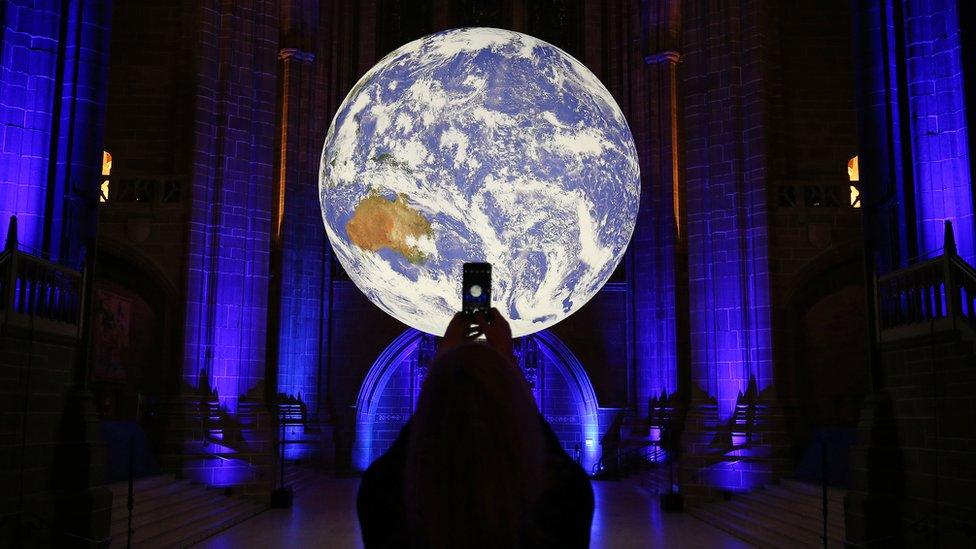
More than 185,000 people saw Gaia in Liverpool Cathedral
Children scampered merrily as their parents gazed in admiration at a large rotating planet Earth in Liverpool and Peterborough, while a model Moon had a similar effect on those venturing inside the cathedrals of Ely and Derby, and a projection of the lunar surface could be walked upon in Lichfield.
In Norwich, thousands whizzed down a helter-skelter, while in Rochester the thwack of golf balls and associated excited squeals echoed as families made their way around a nine-hole crazy-golf course in the nave.
Such schemes have made global headlines, external and attracted criticism, including from the Queen's former chaplain the Right Reverend Dr Gaven Ashenden.
A full-size helter-skelter has been constructed inside Norwich Cathedral
Norwich Cathedral's helter-skelter was a "mistake" and "unprofessional", he said, adding: "For such a place, steeped in mystery and marvel, to buy into sensory pleasure and distraction is to poison the very medicine it offers the human soul."
Rochester's crazy golf course, which attracted 31,500 visitors in six weeks, was also a "really serious mistake", he said.
"The idea that people are so trivial that they can be almost tricked into a search for God by entertaining them with a golf course is a serious-category error."
Rochester Cathedral's crazy golf course divides opinion
But such criticism, which was echoed on social media, missed the point according to the Reverend Canon Andy Bryant of Norwich Cathedral, who often conducts funerals there.
"I often do things that are very serious, sombre and even heartbreaking in the cathedral," he said.
"But surely we also need to celebrate the whole of ourselves; we were also made for love, laughter and fun."
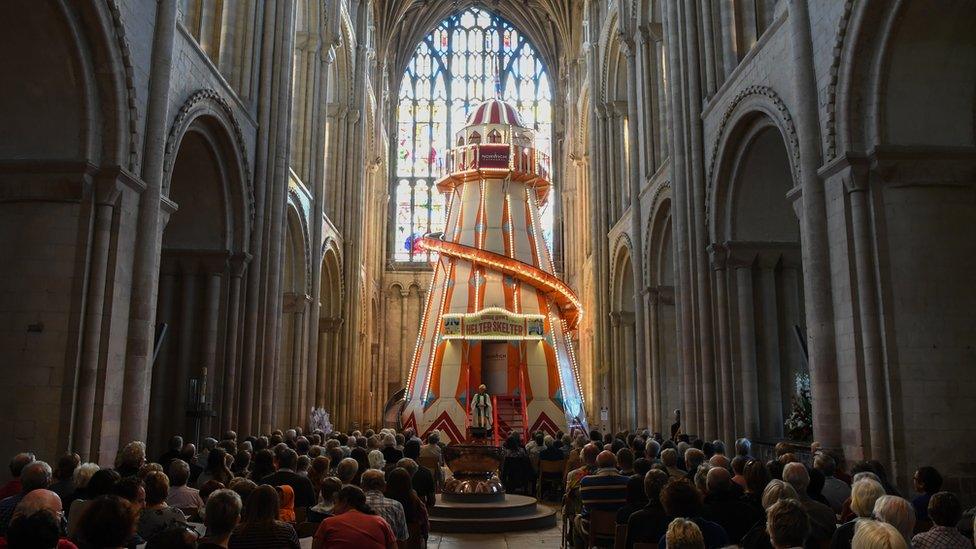
Some 10,000 people used the helter-skelter
The point of the helter-skelter, which was used by 10,000 visitors, was to get people up close to the cathedral's medieval roof bosses, sculptures carved high in the ceiling, Canon Bryant said.
By why use a helter-skelter?
"Why not?" he replied, adding: "The idea was to do it in a playful way.
"It's not something we expect to see in a cathedral and it was all about seeing things differently and provoking conversations.
"If you see a space differently, might you see yourself differently - and even God?"

The lunar surface is being projected on to the floor of Lichfield Cathedral until 25 September, while the ceiling has previously been used for illumination shows
And the cathedral's other functions carried on as normal, he said.
"It's the wonderful nature of a cathedral that at one end you can have people being very still, lighting candles, reading prayers and holding the regular services - all the things you would normally expect to find - while at the other you can have a helter-skelter.
"It's something being added, not taken away."
It proved popular with visitors, with the Reverend Dr Mel Clark tweeting, external she "loved it" as it was "joy, laughter and the divine, caught up in a spiral within sacred space".
Rowan Whiteside said, external: "I think it is the most wonderful thing to have people screaming down a helter-skelter one end, a wedding in the middle, and people praying at the other end."
Cathedral chorister Daniel said it was "very good because you get a brilliant view and get to look at a completely different perspective".
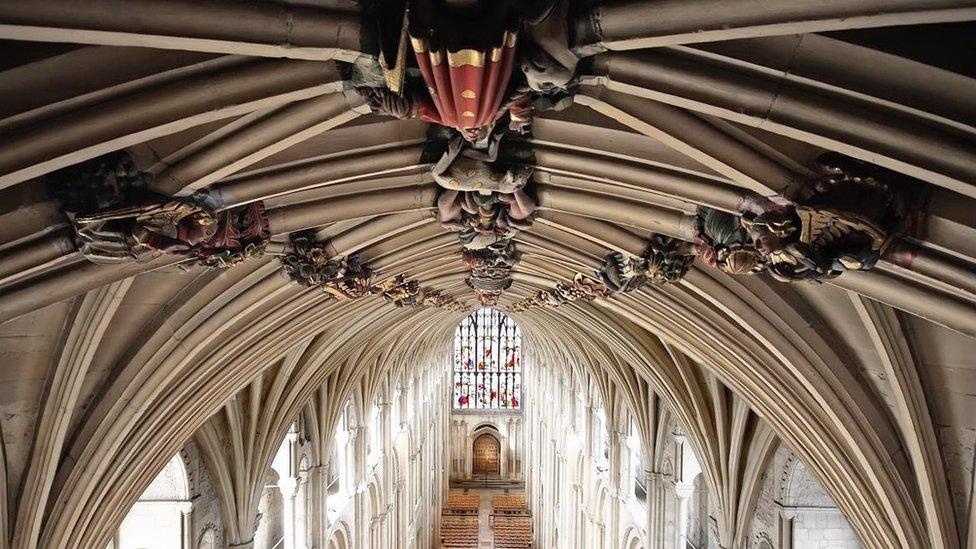
Norwich Cathedral has more than 1,000 sculptures known as bosses
Rochester's crazy golf course was meant to entice people who would not normally go to a cathedral, as well as provide free family fun for the school holidays.
"Many people can feel intimidated by a cathedral," chapter clerk Simon Lace said, adding: "They worry about being shushed and that it is a formal stuffy place.
"We wanted to prove that is not true, we do not shush people but welcome them.
"These are community spaces."
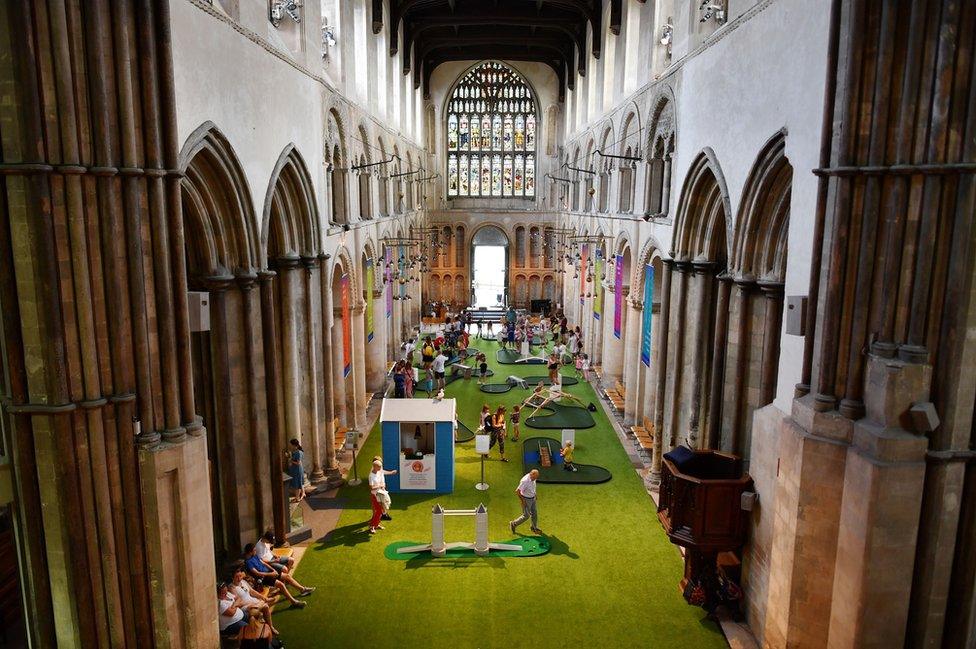
The golf course was created by the Rochester Bridge Trust to encourage young engineers
He said he knew the course would not "convert thousands", but he hoped it had broken the barrier for those who were wary of entering cathedrals.
"Worship is respectful but does not have to be sombre," he added. "Worship should be joyful, and that's what the cathedral was like over the summer - it was joyful."
He said such events were actually a return to the way cathedrals were used in centuries past, when naves often hosted markets and fairs.
"It was only in the Victorian age that that stopped; they were much more po-faced and began to exclude those activities," Mr Lace said.
You might also be interested in:
England's only county without a McDonald's
What's it like to live in a castle?
The hidden dangers of magnet fishing
Cathedrals have been used for huge art projects before, like the Lumiere Festival which began in 2009 by projecting enormous illuminations on to the exterior of Durham Cathedral while the interior hosted spectacular installations.
For the artists, cathedrals offer a large space with stunning backdrops, according to Bristol-based Luke Jerram, creator of the Earth and Moon models that have now been seen by more than five million people in 30 countries.
"The architecture is just beautiful," he said, although he admitted there could be challenges.

Durham Cathedral has been used in the Lumiere festival since 2009
"People come in to see the artwork but the church may want to switch off the music that accompanies it because there is a service happening," he said.
"There might only be 12 people there to pray and 400 to see the art so there is a tension there."
He said as an atheist he is "aware" cathedrals were built "with public money" which could have been "better spent on schools or hospitals".
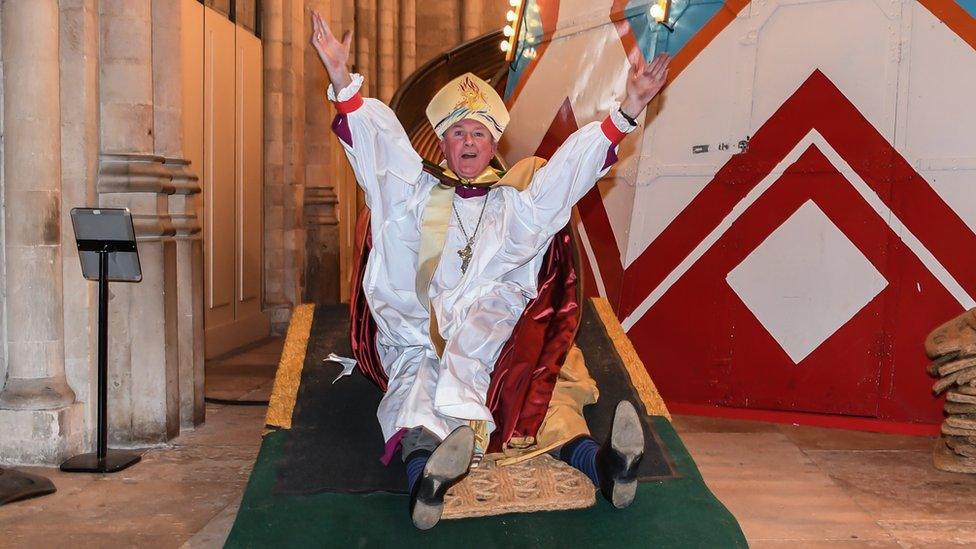
The Bishop of Lynn, the Rt Revd Jonathan Meyrick, gave a sermon from the slide
But they also have an atmosphere conducive to art, Mr Jerram said.
"The experience of gazing up at the Moon or Earth can be very spiritual, so placing it in a spiritual context can help set the mood.
"Having a space designed for contemplation fits, it marries up.
"It's important for people to see just how fragile and beautiful our planet is."
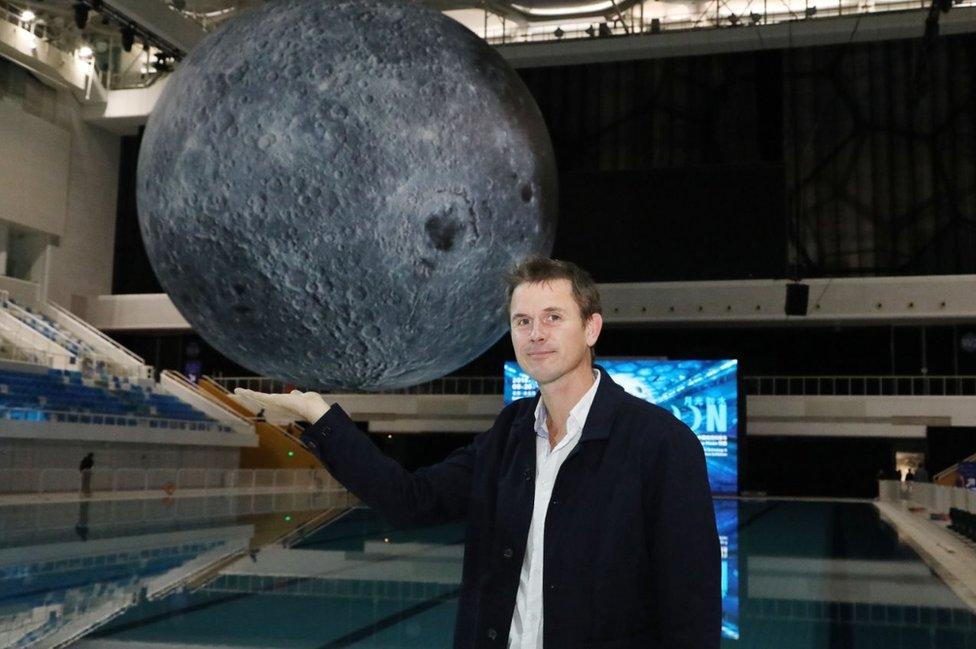
Bristol-based Luke Jerram has created Gaia and the Museum of the Moon exhibitions
The Earth exhibit, named Gaia, was seen by more than 185,000 people in five weeks in Liverpool Cathedral, while the Museum of the Moon display attracted 60,000 in a week last year.
"It attracts people who would not necessarily come into the cathedral," said the dean of the cathedral, the Very Reverend Sue Jones.
"Liverpool Cathedral is big enough to be able to host big art exhibitions with very little impact on the general worshipping community."
The cathedral is also the home of a permanent art installation by Tracey Emin, created when Liverpool was the City of Culture 10 years ago.

Tracey Emin's piece was created for Liverpool's year as the City of Culture
Emin's work features the words "I felt you and I know you loved me" in bright pink neon lights.
"Some people like it and some people hate it," Dr Jones said, adding: "But all can relate to its message.
"We give a huge amount of thought to the art we display and have not taken things we have deemed to be inappropriate.
"What the cathedral tries to do is bring pieces of art that make people think wider and bigger than what's right in front of them."
- Published17 September 2019

- Published18 August 2019
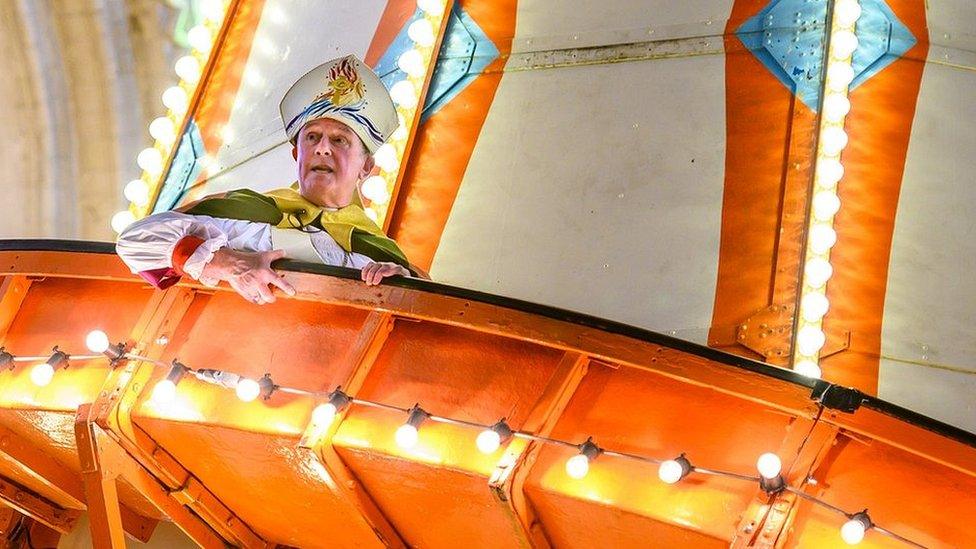
- Published4 September 2019

- Published30 March 2017
